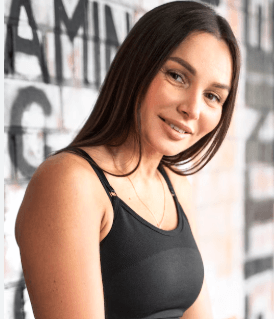Did you know you can get fit at home just like at the gym? With the right mindset and effort, you can see big changes in your body from home.
You don’t need fancy gear or a big space to start seeing results. By doing expert home workouts, you can get your body in top shape. This guide will show you how to do it safely and effectively, no matter your fitness level.
Table of Contents
Key Takeaways
- Discover effective home workouts tailored to your fitness level.
- Learn how to achieve body transformation with dedication and the right routine.
- Understand the importance of a well-structured fitness at home plan.
- Explore expert tips for improving your workout routine.
- Achieve your fitness goals from the comfort of your own home.
The Science Behind Body Transformation at Home
Transforming your body at home is possible when you know the science. It’s important to understand how your body reacts to exercise and food. This knowledge is key for real change.
How Muscle Growth and Fat Loss Work Without Gym Equipment
Muscle growth happens when you do exercises that challenge your muscles. This causes tiny tears that make your muscles bigger. Bodyweight exercises like push-ups and squats can build muscle just like weights do. To lose fat, you need to burn more calories than you eat. High-Intensity Interval Training (HIIT) is great for losing fat without any equipment.
Regular exercise at home changes your body and boosts your health. It can make your heart healthier, improve your mood, and help you live longer. For more tips on losing weight, check out effective weight loss tips.
Research-Backed Benefits of Consistent Home Exercise
Studies prove that regular home workouts improve your health a lot. A study in the Journal of Sports Science and Medicine found big gains in heart health and muscle strength from home workouts.
| Benefit | Description | Evidence |
|---|---|---|
| Cardiovascular Health | Improves heart health and reduces risk of cardiovascular diseases | Journal of Sports Science and Medicine |
| Mental Well-being | Enhances mood and reduces symptoms of anxiety and depression | Harvard Health Publishing |
| Longevity | Increases life expectancy by maintaining physical function | National Institute on Aging |
Understanding the science of body transformation helps you reach your fitness goals at home. Whether it’s bodyweight exercises or simple routines, the secret is to keep going and get stronger. This way, you’ll lose fat and build muscle.
Essential Equipment for Effective Home Workouts
Bodyweight exercises are great, but adding some equipment can make your home workouts more interesting. This section will look at the best options for boosting your home fitness routine.
No-Equipment Bodyweight Exercise Options
You can get a fantastic workout without any equipment. Try push-ups, squats, and lunges. They’re good for building strength and improving heart health. Plus, you can adjust them to fit your fitness level.
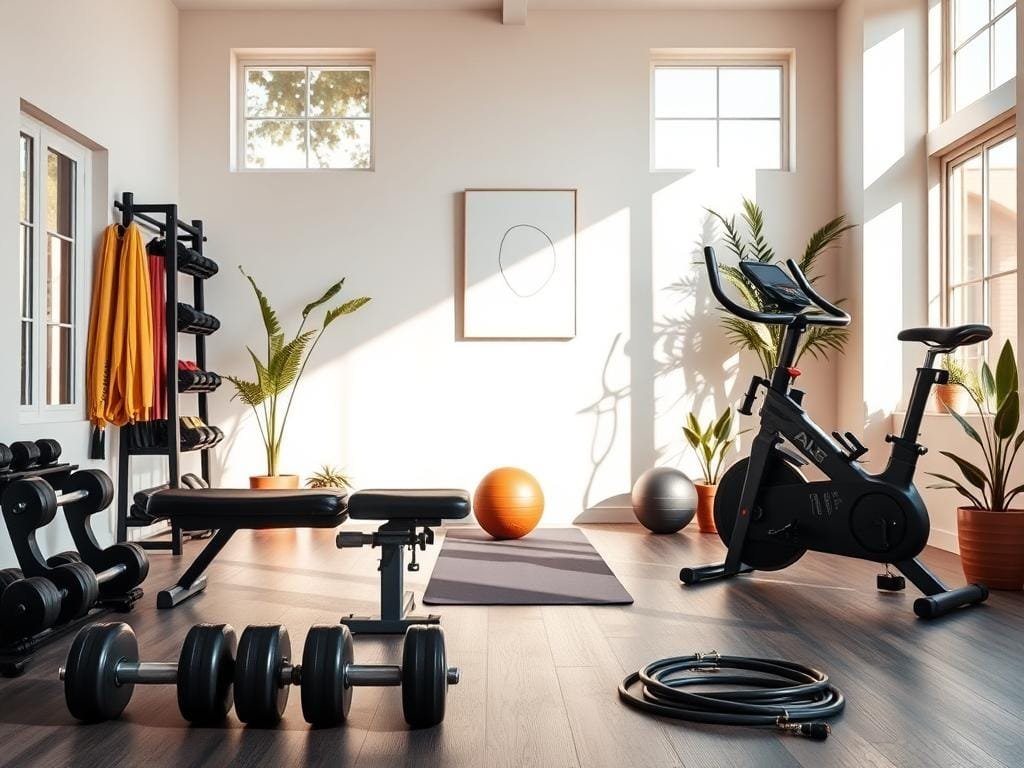
Budget-Friendly Fitness Tools Worth Investing In
Adding a few budget-friendly fitness tools can really help your workouts. Here are some good choices:
| Equipment | Benefits | Cost |
|---|---|---|
| Resistance Bands | Portable, versatile, and great for strength training | $5-$15 |
| Jump Rope | Excellent for cardiovascular workouts and coordination | $5-$10 |
| Adjustable Dumbbells | Space-saving and adjustable for various exercises | $50-$100 |
For more ideas on setting up your home gym, check out Cleveland Clinic’s guide on the best home gym.
Creating an Optimal Workout Space in Limited Areas
You can make a great workout space even with little room. Here are some tips:
- Choose multi-functional equipment that serves more than one purpose.
- Use vertical space with wall-mounted equipment or storage.
- Go for foldable or compact equipment that’s easy to store.
By picking the right equipment and setting up your space well, you can reach your fitness goals from home.
Designing Your Personalized Home Workouts Plan
Your fitness journey starts with a personalized workout plan that meets your unique needs and goals. A good plan keeps you focused and motivated. It helps you move closer to your fitness goals.
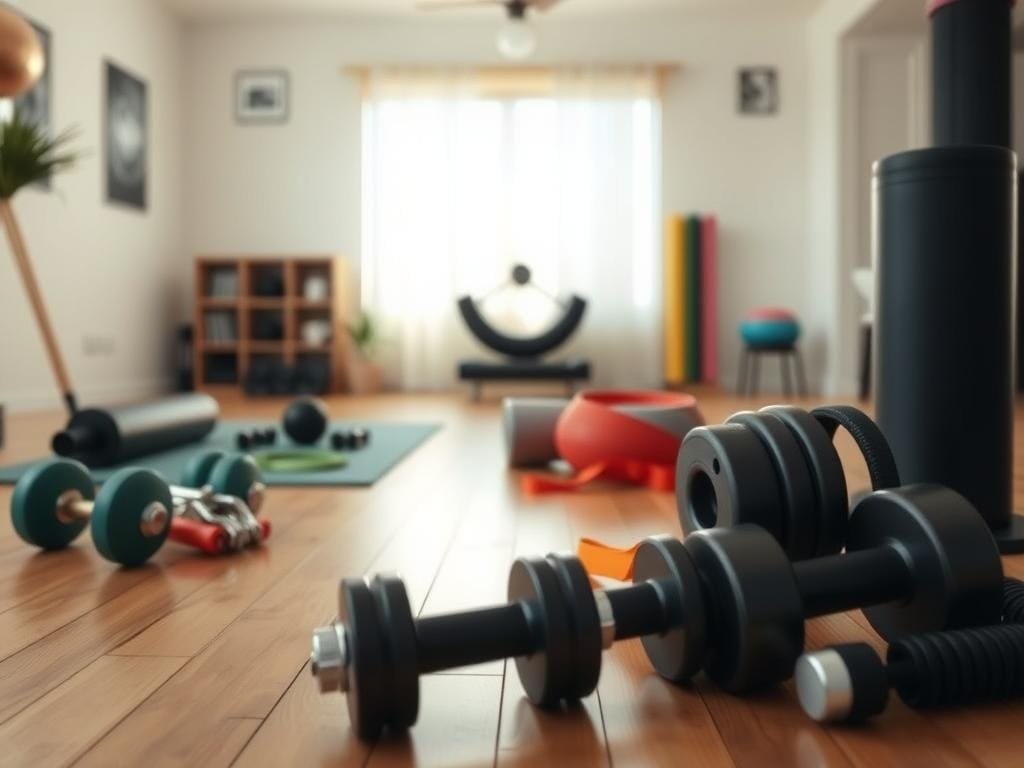
Assessing Your Current Fitness Level Accurately
Before making a workout plan, you need to assess your current fitness level. Look at your strength, endurance, flexibility, and health. Start by tracking your daily activities and heart rate. Try simple tests like push-ups or squats.
For a better assessment, use online tools or talk to a healthcare professional. Fitness expert Jessica says, “Knowing your fitness level is key for a good workout plan” learn more about personalized fitness plans.
Setting SMART Transformation Goals
Setting SMART (Specific, Measurable, Achievable, Relevant, Time-bound) goals is important for success. Your goals should be clear and match your fitness dreams. For example, aim to reduce body fat by 10% in 12 weeks by working out 3 times a week.
- Specific: Define your goal clearly.
- Measurable: Quantify your goal so you can track progress.
- Achievable: Ensure your goal is realistic based on your current fitness level.
- Relevant: Align your goal with your overall fitness aspirations.
- Time-bound: Set a specific deadline for achieving your goal.
Creating a Progressive Weekly Workout Calendar
A progressive weekly workout calendar is key for growth. Start by planning your workouts and then increase the intensity, frequency, or duration. Use a planner, app, or spreadsheet to track your calendar.
“Consistency is key when it comes to fitness. Sticking to your workout plan and progressively challenging yourself will lead to significant improvements over time.”
To make a progressive workout calendar, follow these steps:
- Plan your workouts for the week ahead.
- Start with manageable intensity and volume.
- Gradually increase the intensity, frequency, or duration as you progress.
- Allow for rest and recovery days.
Beginner-Friendly Home Workouts for Total Body Transformation
Starting a fitness journey at home can be thrilling and a bit scary. But, with the right workouts, you can see big changes. Begin with simple routines that match your fitness level. Start with bodyweight exercises that work many muscles at once.
15-Minute Full Body Starter Routine
A full body workout is great for beginners. It targets all major muscles in one go. For a 15-minute routine, do a circuit of squats, push-ups, lunges, and planks.
Start with 3 sets of 10 reps for each exercise. You can always adjust as you get better.
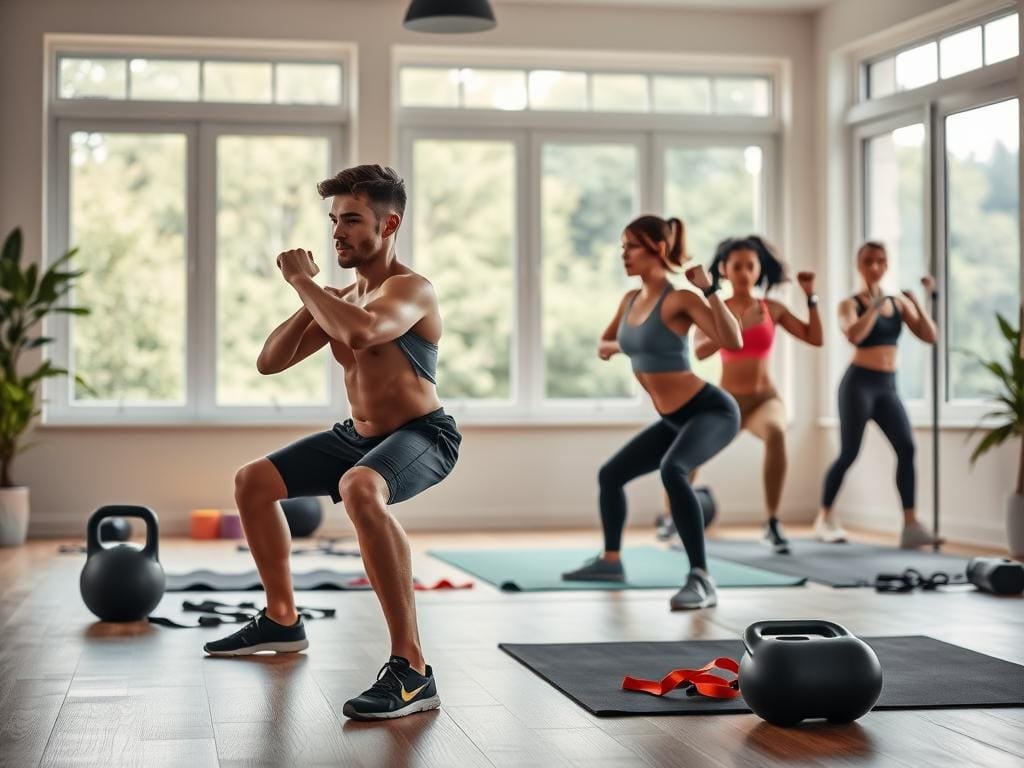
Begin with a dynamic warm-up. Then, do 3 sets of squats, push-ups, and lunges. Finish with a plank hold. As you get more comfortable, you can make your workouts longer or harder.
Progressive Bodyweight Exercise Series
Bodyweight exercises are great because you can change them to fit your level. A progressive series means making exercises harder as you get stronger. For example, start with knee push-ups and move to regular push-ups.
Start with the basic form of an exercise. Once you’re good, make it harder. For tips on making your workouts more challenging, check out this resource on supplements for better performance.
Mobility and Flexibility Foundations for Beginners
Mobility and flexibility are key for a good fitness routine. As a beginner, focusing on these can help avoid injuries and improve how well you do. Simple exercises like leg swings and arm circles can help.
Adding dynamic stretches to your routine can also boost flexibility. Do some light cardio, then stretch the big muscle groups. This will help you move better and recover faster.
Intermediate Home Workouts to Accelerate Your Results
Take your home workout to the next level with intermediate exercises. These workouts are designed to push you harder and help you see better results. As you get more experienced, it’s time to try more challenging and intense exercises.
30-Minute HIIT Routines for Maximum Fat Burning
High-Intensity Interval Training (HIIT) is great for burning fat and improving heart health. It involves short, intense exercises followed by brief breaks. Try a 30-minute routine with burpees, jump squats, and mountain climbers.
For more ideas, check out this guide to effective exercises to lose fat fast at home.
Strength-Building Circuits Without Heavy Weights
Strength training is key for building muscle and boosting metabolism. You don’t need heavy weights to get a good workout at home. Use bodyweight exercises, resistance bands, and light dumbbells for challenging circuits.
Try a circuit with push-ups, squats, lunges, and planks. Do these exercises in a row with little rest in between.
Targeted Workouts for Common Problem Areas
Many people have trouble with specific areas like the abdomen, thighs, or arms. Targeted workouts can help tone and strengthen these spots. For the abdomen, try crunches, leg raises, and Russian twists.
For the thighs, squats, lunges, and leg press variations work well. Arm exercises like push-ups, tricep dips, and bicep curls can tone the upper body.
Adding these intermediate workouts to your routine can speed up your fitness progress. Focus on proper form and technique. And don’t be afraid to make the exercises harder as you get more comfortable.
Advanced Home Workouts for Dramatic Body Transformation
Looking to level up your fitness? Advanced home workouts can lead to a big change. You’ve moved past the easy stuff and now it’s time for tougher routines.
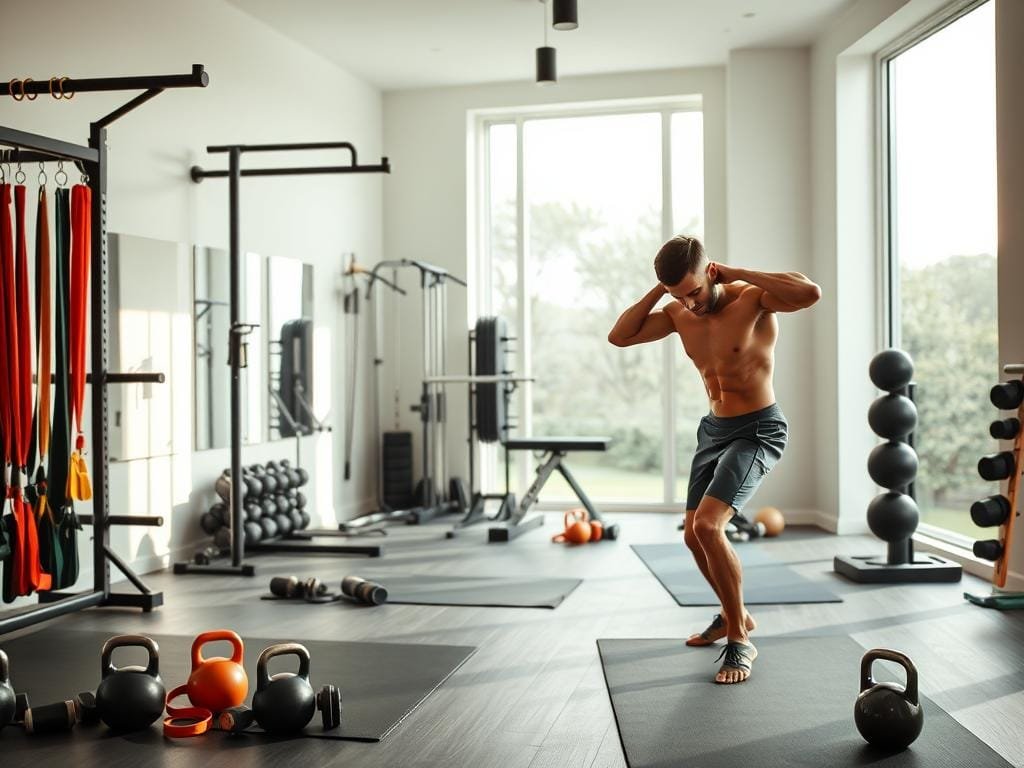
High-Intensity Metabolic Conditioning Protocols
High-intensity metabolic conditioning (MIC) boosts your metabolism. It burns fat and improves heart health. These workouts mix short, intense exercises with brief rests.
Example MIC Protocol: Do 3 sets of 10 reps of burpees, jump squats, and mountain climbers. Rest for 30 seconds between sets.
“The key to successful MIC is to work at maximum intensity during the exercise bursts, allowing for adequate recovery between sets.”
Advanced Resistance Training Techniques
Advanced resistance training uses body weight or little equipment. It pushes your muscles harder. You’ll use plyometrics, isometric holds, and change the tempo.
- Plyometric push-ups for explosive upper body power
- Isometric squat holds for enhanced leg strength
- Slow-tempo lunges for increased time under tension for the legs
Creating Progressive Overload in Limited Space
Progressive overload is key for muscle growth and strength. Even with little space, you can increase reps, sets, or intensity.
For example: Add more push-ups in a set, or cut rest time. Try diamond push-ups or single-leg squats for a challenge.
Adding these advanced techniques to your workouts will help you keep improving. You’ll see a big change in your body.
Nutrition Strategies to Fuel Your Home Workouts
Fueling your body right is key for the best home workouts. A balanced diet gives you the energy and nutrients you need. It also helps your muscles grow and recover, helping you reach your fitness goals.
Pre and Post-Workout Nutrition Essentials
It’s important to eat the right foods at the right time for your workouts. Pre-workout nutrition should give you energy and support your muscles. Eat a meal or snack with carbs, protein, and fats 1-3 hours before working out. A banana with almond butter and nuts is a good choice.
Post-workout nutrition is also vital for muscle recovery and growth. Eat a mix of carbs and protein within 30-60 minutes after working out. A smoothie with protein powder, fruit, and spinach is a great option.
“Nutrition is the key to unlocking your full fitness journey. The right foods can boost your performance, help your muscles grow, and reach your goals.”
Meal Planning for Different Transformation Goals
Good meal planning is essential for reaching your fitness goals. Whether you want to lose weight, build muscle, or stay healthy, a solid meal plan helps. For weight loss, eat low-calorie, nutrient-rich foods. For muscle gain, make sure you get enough protein.
For more meal planning tips, check out Meal Prep Ideas for Weight Loss and Muscle. It shows how to make a meal plan that fits your needs.
Hydration and Supplement Considerations
Hydration is often forgotten but is key for good workout performance. Drink 8-10 glasses of water a day. Stay hydrated before, during, and after your workouts.
Even with a balanced diet, some might need supplements. Talk to a healthcare professional or registered dietitian about supplements like protein powder or creatine.
Common Home Workouts Mistakes and How to Avoid Them
Starting a home workout routine can be exciting. But, knowing the common mistakes is key. Without the right guidance, you might fall into bad habits that slow you down.
Form and Technique Issues Without Professional Guidance
One big challenge is keeping the right form and technique at home. Doing it wrong can hurt you and make your workouts less effective.
To keep your form right, try these tips:
- Look for online resources or fitness apps that show you how to do exercises correctly.
- Record yourself doing exercises to spot any mistakes.
- Begin with lighter weights and slowly add more as you get stronger and more confident.
Overtraining and Recovery Misconceptions
Another common mistake is overtraining. Many think doing more is always better. But, too much can make you tired, lower your performance, and increase injury risk.
It’s important to know how to recover well to avoid overtraining. Here are some tips for recovery:
- Make sure you sleep enough (7-9 hours for most adults).
- Include rest days in your workout plan.
- Use stretching and foam rolling to help your muscles recover.
Here’s a comparison of common workout mistakes and how to fix them:
| Mistake | Consequence | Solution |
|---|---|---|
| Poor Form and Technique | Injury, Reduced Effectiveness | Use Online Resources, Record Yourself, Start with Lighter Weights |
| Overtraining | Fatigue, Decreased Performance, Injury | Ensure Adequate Sleep, Incorporate Rest Days, Use Recovery Techniques |
By knowing these common mistakes and how to avoid them, you can have a safe and effective home workout routine.
Tracking Your Transformation: Measurements Beyond the Scale
Tracking your transformation is more than just seeing results. It’s about understanding your progress and staying motivated on your home workout journey.
The scale can give some insight, but it’s not enough. Physical benchmarks give a fuller view of your progress. They help you stay focused on your goals.
Physical Benchmarks to Monitor Weekly
It’s important to monitor physical changes to see how your body is responding. Here are some key benchmarks to track:
- Weight: Tracking weight can be useful, but it’s not the only indicator.
- Body Measurements: Waist circumference, hip measurements, and other body parts show your transformation better.
- Progress Photos: Regular photos help you see changes that might not be obvious.
- Workout Performance: Seeing improvements in your workouts, like doing more reps or recovering faster, shows your progress.
Digital Tools and Apps for Tracking Progress
In today’s digital age, many tools and apps help track your fitness journey. They offer a complete view of your progress, from workout logs to nutrition tracking.
Some popular options include:
- MyFitnessPal: Tracks your daily nutrition and calorie intake.
- Strava: Great for tracking workouts, like running and cycling.
- Fitbit: Monitors daily activity, sleep, and heart rate.
- Google Fit: Offers a detailed view of your daily activity and workout progress.
By using physical benchmarks and digital tools, you get a deeper understanding of your transformation. This approach helps make informed decisions about your workout and nutrition plan. It ensures you’re always moving towards your goals.
Staying Motivated: Psychology of Successful Home Fitness
Home fitness success isn’t just about the exercises; it’s about keeping your motivation up. To reach your fitness goals at home, you need to know the psychological factors that push you.
Creating Accountability Without a Gym Community
One big challenge of home workouts is the lack of a gym community. This can make you feel like something’s missing. But, you can create your own accountability:
- Share your fitness goals and progress with a friend or family member.
- Join online fitness communities or forums.
- Use fitness apps that allow you to connect with others or compete in challenges.
By setting up these accountability measures, you’re more likely to keep up with your workouts.
Overcoming Plateaus and Mental Barriers
Plateaus and mental barriers are common in fitness. To beat them, remember that progress isn’t always straight. Here are some ways to help you move forward:
| Strategy | Description | Benefit |
|---|---|---|
| Change Your Routine | Alter your workout routine to challenge your body in new ways. | Breaks through plateaus by introducing new challenges. |
| Mindfulness and Meditation | Practice mindfulness and meditation to improve mental resilience. | Helps overcome mental barriers by reducing stress. |
| Set New Goals | Set new, achievable goals to maintain motivation. | Keeps you motivated by giving you something new to work towards. |
By understanding the psychology of motivation and using strategies for accountability and overcoming obstacles, you can succeed in home fitness.
Conclusion: Your Sustainable Path to Fitness Through Home Workouts
Starting a fitness journey at home can change your life. A good routine helps you stay fit and feel better overall.
For a successful journey, do 3-5 workouts a week. Each should last 45 minutes to 1.5 hours. Include strength training to grow muscles and boost metabolism.
Remember to eat enough protein, aiming for 1.6 to 2.2 grams per kilogram of body weight daily. Sleep 7-9 hours each night to help muscles repair and grow. Following these tips and staying dedicated will help you reach your fitness goals.
Keep motivated and track your progress to beat plateaus and mental blocks. With a solid home workout plan, you can change your body and live a healthier life.

